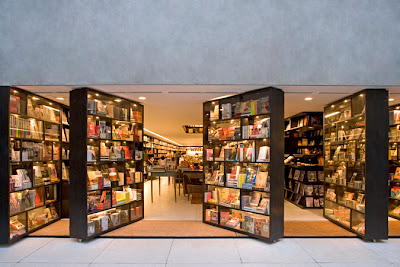this article can be the background and resource for my project, to analysis the situation of bookstore.
Author: Carl King Topics: Business,Marketing,Totally Original Ideas
http://www.carlkingdom.com/why-book-stores-are-closing
A bookstore is An Environment For Discovery. A Gallery of Written Ideas.
For those of us who have been disillusioned by formal education, book stores have offered an escape: a place to stumble onto new shit.
Since way back in high school, when I’ve needed creative juice, I’ve take a random stroll through a book store… to raise my awareness, study independently, and find inspiration in unexpected places. I’d sit down with 4 or 5 books at a time and dig through them. I’d usually go home with at least one.
I’ve purchased around 500 non-fiction books in my lifetime. I can’t put a price on how much I’ve learned from them. It’s millions of dollars worth of knowledge. And it wasn’t only the time I spent turning pages and moving my eyeballs. It was the time I spent staring into space, sitting on the floor of the book store, digesting alien ideas, wondering if this was the book that was going to reveal its secrets to me.
Say what you want about how “books are old media.” But there’s still something special about printing words on paper. It says “these words deserve to be here.” Anyone can make a PDF. It’s when you realize that even the copied words are worth killing a tree or squeezing an octopus.
But it’s not just the book, it’s the experience of being in the book store that matters. Instantly ordering and downloading exactly what you want with one click is not the same — and if you think it is, you’re one step closer to living in the fucking Matrix.
So long as people have physical bodies, GOING TO PLACES and DISCOVERING NEW THINGS THAT YOU CAN TOUCH will matter. That can’t happen when everything is linked and indexed and blurbed and reviewed and meta-tagged into sterility. 5,278,945 people Like this? Who cares?
Chaos must be involved. The element of surprise.
Me? I go to the book store to find what I’m NOT looking for. I want the book that I see out of the corner of my eye, just a few letters of the spine showing on the top shelf. Way up there, hiding from me. Probably in the wrong section, something I’ve never heard of. I don’t know who else has read it, and I don’t care. (Coincidentally, while writing this blog entry, I used some writing techniques I learned from The Art of Nonfiction by Ayn Rand — which I discovered during the above experience last weekend.)
If I only read books that I’m looking for, they’ll tell me what I already know. What good is that?
I admit… that was getting harder to experience, because there are too many published books to keep in one store. Only the cheesiest, pot-boiling easy-sellers were kept in stock. I’d see several square miles dedicated to a bullshit biography on Lady Gaga (or some other pseudo-celebrity that’s “famous for being famous”) while anything published more than a week ago was in Clearance. That is, unless it happened to be on a required reading list — and we know all those books are time-honored crap for conformists.
Sad.
Why not go to the library, then? Because their collection is made of whatever people decide to abandon, stuff they couldn’t even give away.
There must be a solution, right?
Boutique shops like Writers Store in Burbank have figured that one out. Nurture a community (give seminars, panel discussions), stock the best products and tools for a particular profession (writing), and most importantly — make people feel inspired. I always think, “Just by walking in here, I’m a real writer.” Makes me wanna go home and get to work, but not before I buy something to thank them.
I think Private Libraries are another fantastic business idea. Old books, new books, it doesn’t matter — as long as they’re personally-selected for a devoted audience. Instead of coffee shops, why not pay to hang out in a media library personally selected by the Coen Brothers or Kevin Smith? Go there and study all day. I think we’ll be seeing those popping up in the future. If I’m lucky.
Let’s hope that the businessmen behind book stores grow to understand what a book store is really about, and can turn this all around. I repeat: it’s not about selling widgets. I’d hate to see book stores go extinct because they can’t understand that simple premise.











